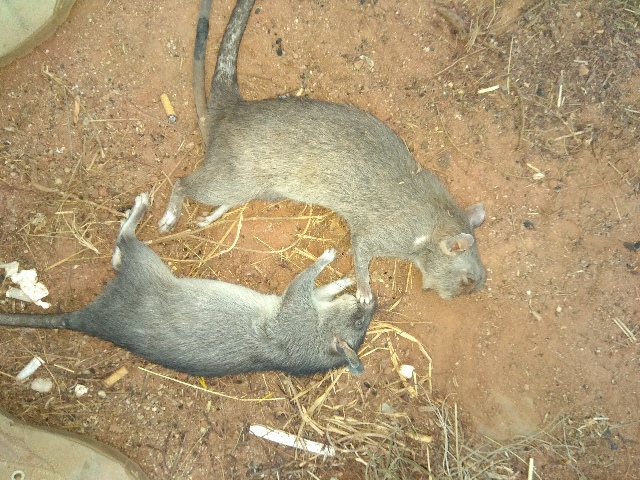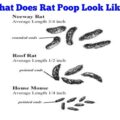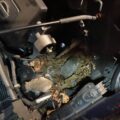Rats are always in search of warm, dry harbourages and new food sources, particularly during periods of inclement weather. Rodents are nocturnal and can be very difficult to spot in the daytime, except when they are dead.
What Types of Rats Are You Likely to Come Across?
There are three types of rats most commonly found in homes or office buildings:
Norway rat
This rodent is known by numerous names, including street rat, sewer rat, brown rat, and wharf rat. The Norway rat can grow up to 10 inches long and weighs in at close to a pound. Norway rats tend to make their homes wherever humans live and often prefer urban areas.
Pack rat
These types of rats come by their names honestly, as they love to snag shiny objects and take them back to their nests. Sometimes they even drop the food they’re carrying to take a treasure, which is why they’re also called trade rats. Pack rats are about eight inches long (not including their tails) and range in color from cinnamon or brown to gray or buff.
Roof rat
Also known as the black rats, roof rats can grow to 10 to 12 inches in body length (add another 10 inches for the tail) and can weigh up to 1 pound. In addition to being black, they also come in shades of brown and gray. You may be more likely to encounter roof rats in fall and winter when their natural outdoor food sources run dry.
How To Dispose Of A Dead Rat
- Because of the threat of Lassa fever, a viral infection carried by the multimammate rat Mastomys natalensis (M. natalensis). You will need to wear a mask.
- After donning your mask and protective gear, find yourself some rubber gloves.
- If you don’t have any of those on hand, a plastic bag turned inside out can be used to pick up the rodent and seal him inside all in one fell swoop.
- Also, if the dead rodent is in a trap, it is still recommended to handle the trap with gloved hands to minimize your exposure to any pathogens.
- If you have located rodent-soiled objects or nesting materials you will want to remove these with gloved hands as well. Add them to the bag with the rodent, sealing them up tightly.
- No need to try to remove the extra air from the bag. Keep all the germs right in the bag!
- Now you can dispose of the bag and its contents in the trash. You may wish to double bag the contents, to prevent any smells from escaping the bag until pick up and remove the trash to an outside bin while you’re at it. Oh – and of course, wash your hands and any potentially contaminated surfaces when you are through!
- You can also Recycle it (aka bury it). Put it well underground in the garden and let it naturally complete the circle of life. You probably want to get it down at least 10 cm, more if you’ve got curious, bored or just plain hungry dogs around who might dig it up.
How to Keep Rats Away
The best strategy is to keep this kind of pests out of your home to start with. Once an infestation has begun they are hard to get rid of. Here are eight steps you can take to keep these rodents out of your home:
Fill holes, cracks, and gaps
Rats can slip into holes the size of a quarter. Check your home for any opening that size and larger. Seal them up with proper materials. These include steel wool, hardware cloth, caulk, cement, and plaster. Weather-strip doors and windows if there are large cracks.
Don’t feed them
Rats are resourceful. They will find things to eat around your property, so you have to be diligent in dealing with them. Cover garbage cans at all times. Pick produce from your garden and trees as it ripens. Pick up and compost fruit and vegetables that fall to the ground. Feed outdoor pets during the day and don’t leave leftover food lying around. Don’t store pet food outside without making sure it’s in rodent-proof containers.
Remove their habitat
Don’t give these vermin a place to live. Remove debris such as limbs, old cars, or appliances from your property. If you have woodpiles or lumber, store them at least 18 inches above the ground and a foot or so away from your home and other walls. Remove heavy vegetation, as rats consider this is a great hiding place.
Trim trees, shrubs, and limbs back four feet from your home
Rats aren’t Olympians; they can’t bridge that gap.
Set traps inside
There are several commercially available traps to catch rats inside your home that are not dangerous to pets and children, for example, cage traps.
Use baits and poisons outside
Toxic baits and poisons should be used outside the home. Rats can spread poison inside your home, making it dangerous for all. Always read and follow label directions. Make sure rat bait is in an enclosed bait station. Keep the bait where children and pets can’t reach it.
Check your neighborhood
Chances are, rats are a neighborhood issue. If you have a rat problem, it’s probably you won’t be the only one dealing with these rodents. Band together with neighbors to check community areas for rat activity. Take the same steps listed above in these areas.
Call the pros
In general, the most effective step for eliminating rats is to call on professional rat exterminators when you see evidence of a rat infestation. Rats are dangerous, so it’s best not to take a chance when dealing with them. Expert help will give you much better results than working on your own. Rats are one of the most frustrating household pests. They harbor diseases, they cause destruction to your house, and they contaminate your food. SEE: How Indocid Kills Rats






